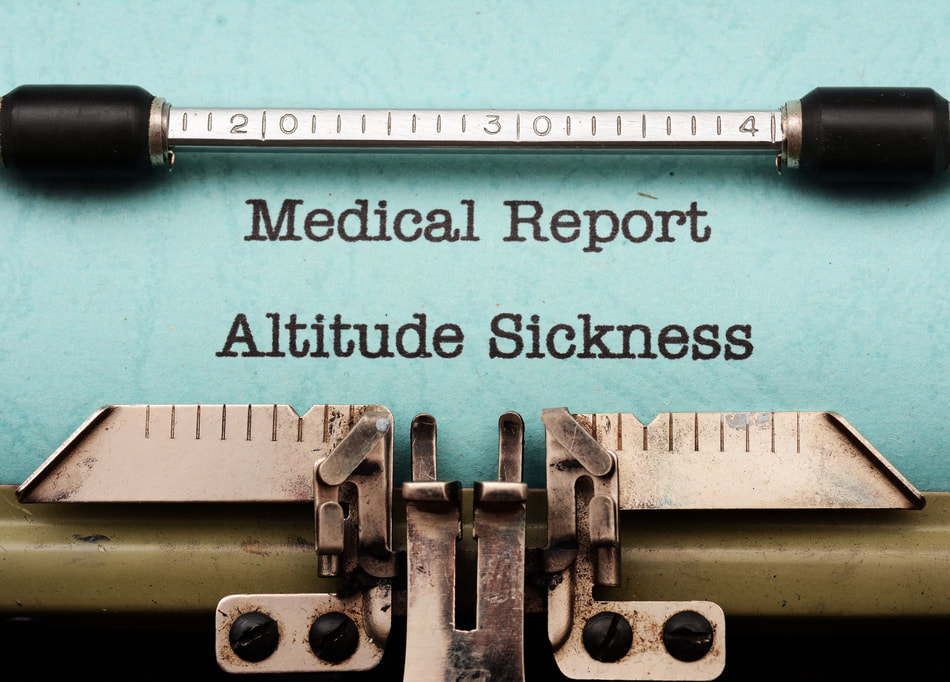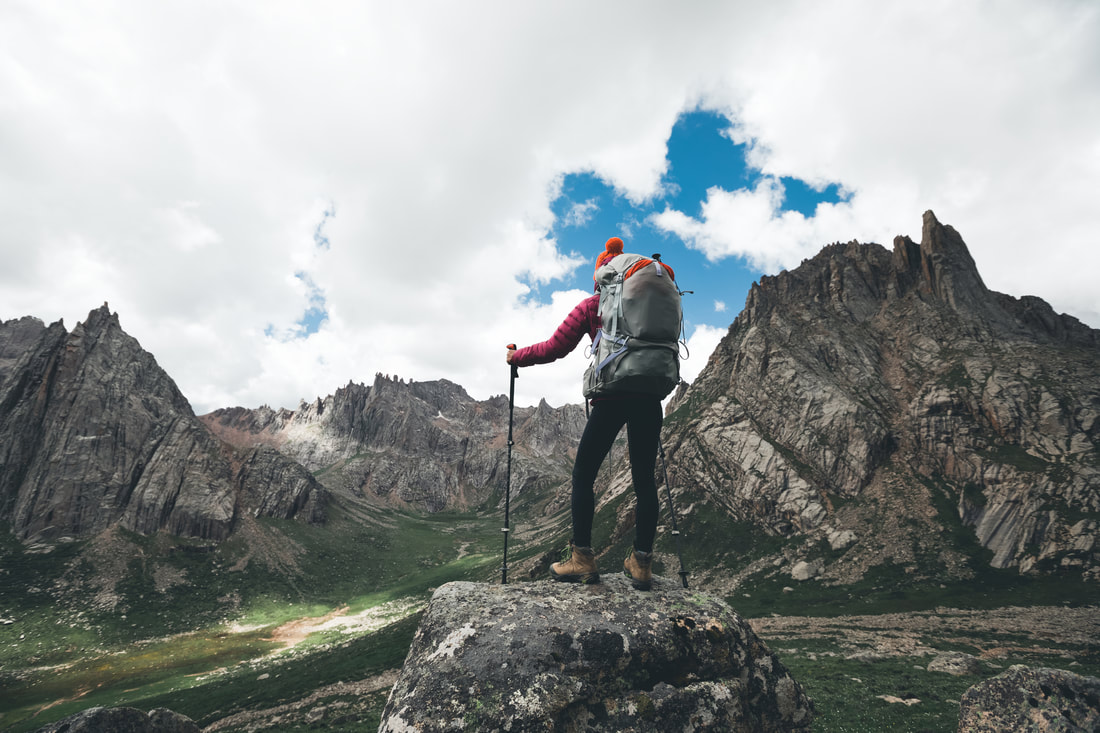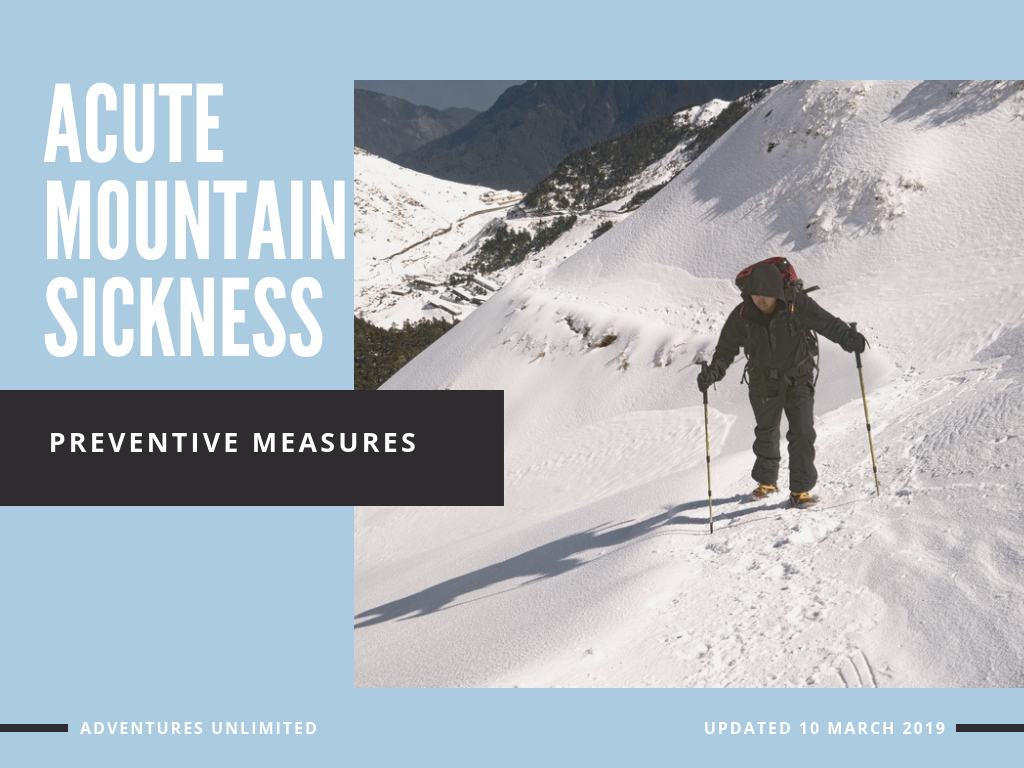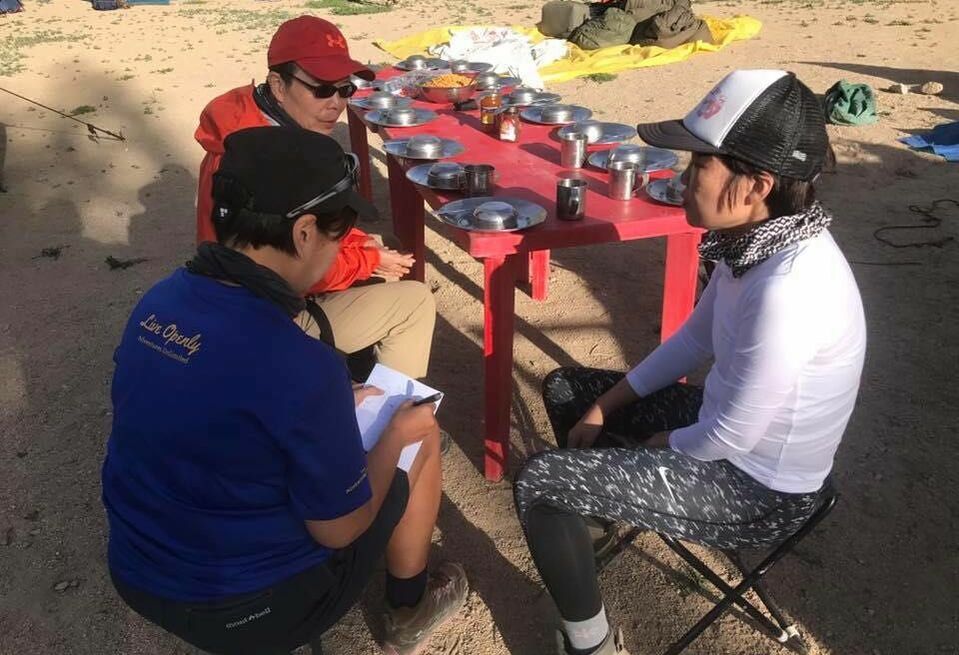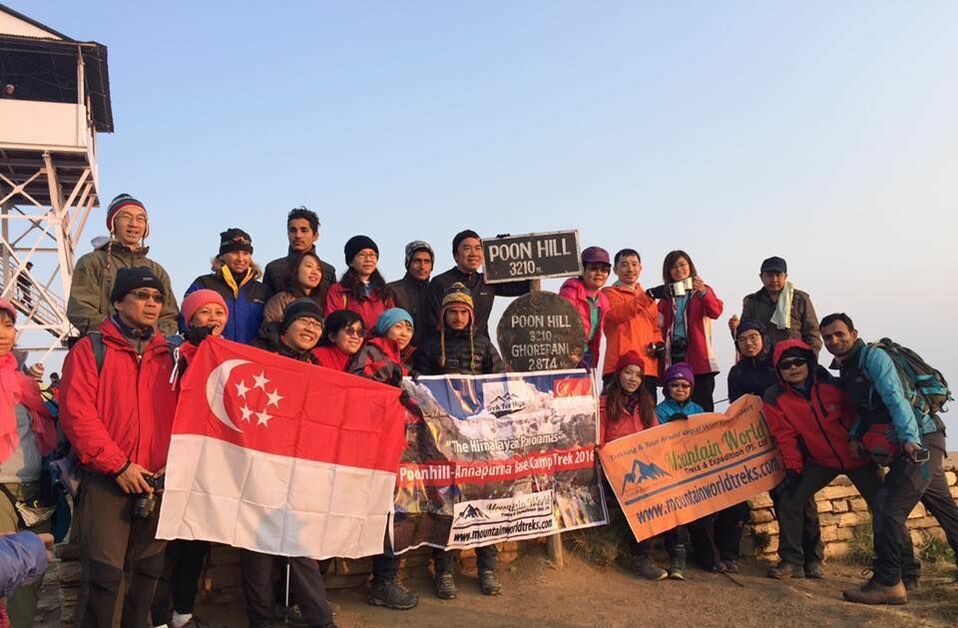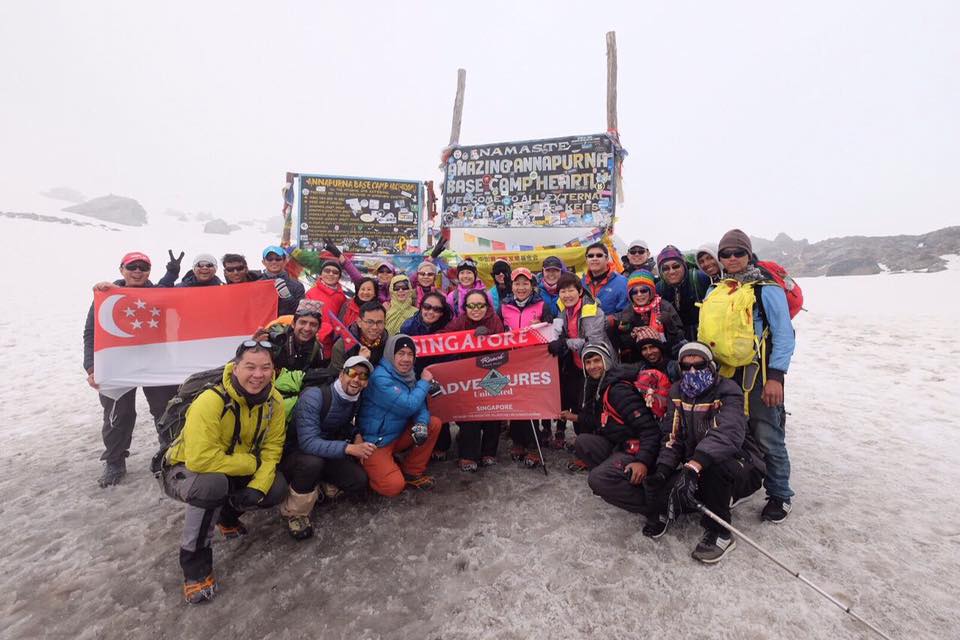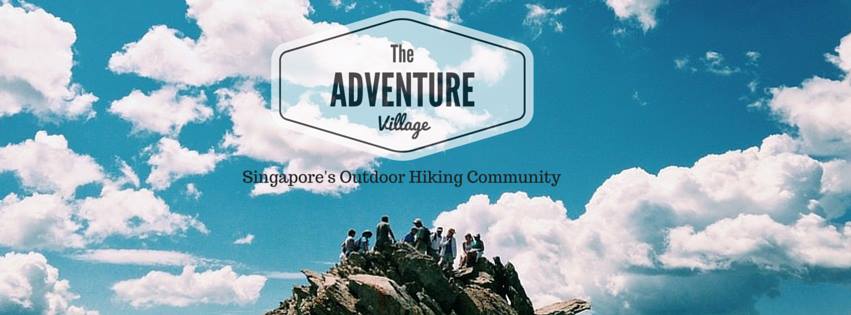Altitude Sickness
Symptoms
Altitude sickness is the human body’s reaction to atmospheric pressure and a reduction of the concentration of oxygen present in the air. As you climb higher into the mountains, your body gradually adapts to the reduced amount of oxygen in the air. The appearance of altitude sickness symptoms shows that your body has increased its altitude level faster than it can acclimatize to the corresponding change in atmospheric pressure and reduction in oxygen. In trekking, altitude acclimatization processes are different for each trekker.
Whilst trekking in such places anyone can fall ill with high altitude sickness regardless of their body shape, experience and previous mountain trekking experience. There’s no need to fear high altitude sickness, but it’s very important that you know how to avoid it, how to recognize it and how to act correctly in the event that you encounter symptoms of altitude sickness.
In rare cases, symptoms of altitude sickness may begin to appear starting from 2,400 meters above sea level, but an increased risk of high altitude sickness sets in starting from the 3,500 meter mark. The high risk or mountain zone starts from 5,500 meters.
Symptoms
Altitude sickness is the human body’s reaction to atmospheric pressure and a reduction of the concentration of oxygen present in the air. As you climb higher into the mountains, your body gradually adapts to the reduced amount of oxygen in the air. The appearance of altitude sickness symptoms shows that your body has increased its altitude level faster than it can acclimatize to the corresponding change in atmospheric pressure and reduction in oxygen. In trekking, altitude acclimatization processes are different for each trekker.
Whilst trekking in such places anyone can fall ill with high altitude sickness regardless of their body shape, experience and previous mountain trekking experience. There’s no need to fear high altitude sickness, but it’s very important that you know how to avoid it, how to recognize it and how to act correctly in the event that you encounter symptoms of altitude sickness.
In rare cases, symptoms of altitude sickness may begin to appear starting from 2,400 meters above sea level, but an increased risk of high altitude sickness sets in starting from the 3,500 meter mark. The high risk or mountain zone starts from 5,500 meters.
The primary symptoms of Acute Mountain Sickness (AMS) are:
-Headache
-Loss of appetite
-Nausea
-Vomiting
-Fatigue and weakness
-Dizziness
-Restless sleep
-Shortness of breath
-Swelling of the face and hands.
Mild altitude sickness symptoms are experienced by about up to 20% of trekkers at altitudes of up to 3,000 meters above sea level.
At extreme altitudes, above 4,500 meters, Acute Mountain Sickness can turn into High Altitude Pulmonary Edema (HAPE) or High Altitude Cerebral Edema (HACE) which are both very serious.
High Altitude Pulmonary Edema (HAPE) symptoms include: serious fatigue, shortness of breath and dry cough, shortness of breath at rest, rapid and shallow breath, frothy or pink mucus possible, gurgling, rasping sound when breathing, pressure, heavy feeling in the chest, restlessness, rapid pulse, possible fever, cyanosis – blue or gray lips and indescribable lethargy.
High Altitude Cerebral Edema (HACE) symptoms include: powerful headache which doesn’t pass using painkillers, loss of coordination (ataxia), vomiting, apathy, fatigue, indifference, walks as if drunk, behavioral changes, confusion, hallucinations, cramping fits, short-term blindness and numbness or paralysis of individual body part.
HACE is the most dangerous form of high altitude sickness. It progresses rapidly and requires quick action to prevent the trekker’s death. You may only have a few hours time to successfully implement rescue measures depending on the degree of seriousness of HACE.
Treating AMS With Medication
#1. Acetazolamide is a diuretic, so it was used to treat glaucoma. It has also been found to help with mountain sickness. A doctor without any climbing experience may not agree that this medicine can provide relief of the symptoms, so the wrong message is sent. An incorrect dosage might be recommended and that can cause a potential overdose if taken on the mountain.
If you ask about AMS medicines, you may receive a recommendation to take a different prescription. It is up to you if you wish to pay the added cost.
#2. Purchasing directly from a pharmacy where only drug names are handwritten onto drug bags creates a potentially dangerous situation. It is impossible to trace the source of the medication in this circumstance. Unless you can identify drugs and are certain of its purity, it is not recommended to purchase open medicines at the pharmacy.
#3. Don’t purchase drugs from others. They are not allowed to be distributed privately and you could be breaking the law.
#4. If there are no medical personnel, seek advice from the your trek guide in an emergency.
#5. Acetazolamide is a sulfa drug, so be aware of any allergic reactions you may have. An allergy to medication can develop at any time, even if you’ve never experienced a reaction in the past. Always follow the warnings and pay attention to the side effects that are listed for the medication. Never take a medicine for altitude sickness for the first time on a mountain. You’re a long way from help and some allergic reactions can be life-threatening.
Mountaineering is about taking personal responsibility for your actions while still caring for your teammates. Avoiding trouble whenever possible must be a priority. You must prepare basic medications before climbing the mountain and seek medical advice from a professional provider. Then, should you become distressed, you can save yourself with the prescriptions you have taken with you.
Be aware of the symptoms of AMS, especially if you’ve never experienced them before. Many of the early signs are often ignored by beginners. Do not take this issue lightly. It becomes difficult to treat the symptoms once they become serious.
#1. Acetazolamide is a diuretic, so it was used to treat glaucoma. It has also been found to help with mountain sickness. A doctor without any climbing experience may not agree that this medicine can provide relief of the symptoms, so the wrong message is sent. An incorrect dosage might be recommended and that can cause a potential overdose if taken on the mountain.
If you ask about AMS medicines, you may receive a recommendation to take a different prescription. It is up to you if you wish to pay the added cost.
#2. Purchasing directly from a pharmacy where only drug names are handwritten onto drug bags creates a potentially dangerous situation. It is impossible to trace the source of the medication in this circumstance. Unless you can identify drugs and are certain of its purity, it is not recommended to purchase open medicines at the pharmacy.
#3. Don’t purchase drugs from others. They are not allowed to be distributed privately and you could be breaking the law.
#4. If there are no medical personnel, seek advice from the your trek guide in an emergency.
#5. Acetazolamide is a sulfa drug, so be aware of any allergic reactions you may have. An allergy to medication can develop at any time, even if you’ve never experienced a reaction in the past. Always follow the warnings and pay attention to the side effects that are listed for the medication. Never take a medicine for altitude sickness for the first time on a mountain. You’re a long way from help and some allergic reactions can be life-threatening.
Mountaineering is about taking personal responsibility for your actions while still caring for your teammates. Avoiding trouble whenever possible must be a priority. You must prepare basic medications before climbing the mountain and seek medical advice from a professional provider. Then, should you become distressed, you can save yourself with the prescriptions you have taken with you.
Be aware of the symptoms of AMS, especially if you’ve never experienced them before. Many of the early signs are often ignored by beginners. Do not take this issue lightly. It becomes difficult to treat the symptoms once they become serious.
It Is Also Possible to Treat AMS with Basic Prevention Techniques
Medical treatments can help with mountain sickness when the symptoms begin to make themselves known. In addition to taking medication on your own, you can reduce the chances of AMS occurring by implementing basic prevention techniques.
#1. Get enough sleep. Fatigue can easily lead to mountain sickness, so get enough sleep the night before. It is a good idea to get a full night of rest for 2-3 days before your journey to ensure the body has enough rest, especially since climbing a mountain can be strenuous.
#2. Do not climb if you have physical discomforts. If you have a cold, an illness, reduced immunities, or physical discomforts, then you have an increased risk of experiencing mountain sickness. Wait until you recover before climbing.
#3. Adapt to the altitude. Rapid changes in altitude can also increase the risk of mountain sickness. A good hiking plan should allow climbers the time necessary to adapt to the new height. That is why many climbing treks involve “sleeping low, climbing high.” The shelter is at a lower altitude than the trek itself. Training at altitudes above 3,000m at least 30 days before a planning climbing trek can also help you adapt to altitude.
#4. Remember to breathe. When climbing, do not try to walk vigorously. Walk slowly and take deep breaths. Allow your body to adapt. If your heart begins to race or you develop a headache while resting, then deep breathing can provide some relief.
#5. Keep yourself warm. Cold weather can increase the risks of mountain sickness. Put on a coat when resting, even if you feel warm, because less physical activity will cause body temperatures to lower. Change into dry clothes. Wear a fur cap while sleeping and never take the hat off when on the mountain since most of the heat from your body will escape through your head.
#6. Consume hot drinks and dense caloric foods. High-calorie foods and hot drinks will give you energy, warm the body, and reduce the risks of developing mountain sickness. Hot ginger tea, hot black syrup, and hot cocoa are all good options. Make sure to drink plenty of water and remember to eat in small amounts and have many meals instead of a few large ones.
#7. Keep proper ventilation. If you are in a crowded tent, do not keep it tightly closed. Oxygen levels dip at night and this will cause a poorly ventilated tent to create poor sleep conditions. Breathe deeply several times with abdominal breathing if you develop a headache as this can slow the symptoms. If you cannot sleep, still close your eyes and rest to the best of your ability.
#8. Use tapping techniques to release pressure. Pressure can build in your head as you gain in altitude and this can lead to discomfort. If the pressure is not released, it can increase the risks of mountain sickness. Use tapping techniques to relieve this pressure.
#9. Take preventative medication. If you do experience the symptoms of AMS, be sure to take prescription medication according to the instructions provided by the doctor and/or pharmacist.
#10. Do not take other medications. Medication interactions can make you feel worse instead of better. Do not bring sleeping pills to take with AMS medicine. You may wish to avoid drinking certain juices as well, since some can change how the medicine works in the body.
#11. Alcohol should not be taken on a mountain trek. Alcohol interacts with medications and should not be taken on a high-altitude trek. It may also enhance the symptoms of mountain sickness.
#12. Do not take a bath in the mountains. Bathing opens the pores of the skin, making a person more susceptible to the cold. Use wet tissues with hot water to wipe the body when necessary.
#13. Pay attention to physical changes. Do not attempt to hide any symptoms you may be experiencing. Share discomforts with your team. Encourage teammates to do the same. This helps everyone make sure the whole team can stay safe and enjoy the high-altitude trek.
#14. Make sure beginners know what to do. For teammates on their first mountain trip or mountain overnight excursion, make sure the leader of the trip knows that they are a beginner so that any issues can be observed and treated immediately. Beginners may not understand that something may be wrong.
#15. Treat it early. Early detection of mountain sickness makes it possible to avoid deterioration.
Medical treatments can help with mountain sickness when the symptoms begin to make themselves known. In addition to taking medication on your own, you can reduce the chances of AMS occurring by implementing basic prevention techniques.
#1. Get enough sleep. Fatigue can easily lead to mountain sickness, so get enough sleep the night before. It is a good idea to get a full night of rest for 2-3 days before your journey to ensure the body has enough rest, especially since climbing a mountain can be strenuous.
#2. Do not climb if you have physical discomforts. If you have a cold, an illness, reduced immunities, or physical discomforts, then you have an increased risk of experiencing mountain sickness. Wait until you recover before climbing.
#3. Adapt to the altitude. Rapid changes in altitude can also increase the risk of mountain sickness. A good hiking plan should allow climbers the time necessary to adapt to the new height. That is why many climbing treks involve “sleeping low, climbing high.” The shelter is at a lower altitude than the trek itself. Training at altitudes above 3,000m at least 30 days before a planning climbing trek can also help you adapt to altitude.
#4. Remember to breathe. When climbing, do not try to walk vigorously. Walk slowly and take deep breaths. Allow your body to adapt. If your heart begins to race or you develop a headache while resting, then deep breathing can provide some relief.
#5. Keep yourself warm. Cold weather can increase the risks of mountain sickness. Put on a coat when resting, even if you feel warm, because less physical activity will cause body temperatures to lower. Change into dry clothes. Wear a fur cap while sleeping and never take the hat off when on the mountain since most of the heat from your body will escape through your head.
#6. Consume hot drinks and dense caloric foods. High-calorie foods and hot drinks will give you energy, warm the body, and reduce the risks of developing mountain sickness. Hot ginger tea, hot black syrup, and hot cocoa are all good options. Make sure to drink plenty of water and remember to eat in small amounts and have many meals instead of a few large ones.
#7. Keep proper ventilation. If you are in a crowded tent, do not keep it tightly closed. Oxygen levels dip at night and this will cause a poorly ventilated tent to create poor sleep conditions. Breathe deeply several times with abdominal breathing if you develop a headache as this can slow the symptoms. If you cannot sleep, still close your eyes and rest to the best of your ability.
#8. Use tapping techniques to release pressure. Pressure can build in your head as you gain in altitude and this can lead to discomfort. If the pressure is not released, it can increase the risks of mountain sickness. Use tapping techniques to relieve this pressure.
#9. Take preventative medication. If you do experience the symptoms of AMS, be sure to take prescription medication according to the instructions provided by the doctor and/or pharmacist.
#10. Do not take other medications. Medication interactions can make you feel worse instead of better. Do not bring sleeping pills to take with AMS medicine. You may wish to avoid drinking certain juices as well, since some can change how the medicine works in the body.
#11. Alcohol should not be taken on a mountain trek. Alcohol interacts with medications and should not be taken on a high-altitude trek. It may also enhance the symptoms of mountain sickness.
#12. Do not take a bath in the mountains. Bathing opens the pores of the skin, making a person more susceptible to the cold. Use wet tissues with hot water to wipe the body when necessary.
#13. Pay attention to physical changes. Do not attempt to hide any symptoms you may be experiencing. Share discomforts with your team. Encourage teammates to do the same. This helps everyone make sure the whole team can stay safe and enjoy the high-altitude trek.
#14. Make sure beginners know what to do. For teammates on their first mountain trip or mountain overnight excursion, make sure the leader of the trip knows that they are a beginner so that any issues can be observed and treated immediately. Beginners may not understand that something may be wrong.
#15. Treat it early. Early detection of mountain sickness makes it possible to avoid deterioration.
Preventing Severe AMS
This simply cannot be emphasized too much. If you have symptoms of AMS, DO NOT ASCEND ANY HIGHER. Violating this simple rule has resulted in many tragic deaths.
If you ascend with AMS you will get worse, and you might die. This is extremely important – even a day hike to a higher elevation is a great risk. In many cases of High Altitude Cerebral Edema, this rule was violated. Stay at the same altitude (or descend) until your symptoms completely go away. Once your symptoms are completely gone, you have acclimatized and then it is OK to continue ascending. It is always OK to descend, you will get better faster.
Treatment
The best way to treat altitude sickness symptoms is to descend. With Acute Mountain Sickness it is best to descend at least 400-500 meters or to the previous altitude at which there were no symptoms. With HAPE and HACE, one should descend immediately 500 - 1000metres. Trekkers should rest for a day or two and drink lots of fluids. If symptoms have completely disappeared, the trekker can ascend again. If symptoms continue to worsen the victim should continue to descend or be evacuated.
NOTE: In this situation, the affected trekker will need to go down to lower elevation. We will arrange for a guide to accompany the sick person and rest of the members keep continue in their journey.
Pre-Trip and Equipment to standby (by our office). We do not take any chance to rely on our foreign operators to provide equipment.
1. All climbers are advised to see a local doctor prior to the trip to seek medical advice and obtain prescribed meds for AMS treatment. This will be enforced if we are trekking above 3,500m at any point of the journey.
It is important that you inform your trek leader of any medical conditions or medications before ascending to altitude.
2. Travel Insurance is compulsory (in case of a heli-evac, participant can claim the cost from insurance company and need not bear the entire cost)
3. Oxgen bottles
In case of an emergency, O2 will be provided. The cost of usage are claimable with your insurance company.
4. Blood Pressure Machine (Why do we need it?)
If the blood pressure is too low the patient may not receive adequate blood flow to the brain and heart and could die within minutes.
If the blood pressure is too high the patient will become unstable and may experience heart failure or stroke.
We monitor the blood pressure frequently because small changes in the pressure readings over a period of time can give us clues about the cardiovascular and respiratory health of the patient. We can be guided by changes in the pressure readings to add or remove certain medications from the patient’s treatment regimen.
5. Pulse oximetry – compulsory readings daily (Why do we need it?)
Pulse oximetry is a test used to measure the oxygen level (oxygen saturation) of the blood.
It may be used:
7. Walkie Talkie
1 for Event host and 1 for co-host (if any)
1 for the group leader, 1 for leading guide and one for the assistant guide
Your trek leader reserves the right to make the decision that you or a member of your group is at risk of serious altitude sickness and for safety insists that you cannot ascend further – please respect that they are within their rights to do so and are making that decision in the best interests of your health and well-being.
Any calls for evacuation must first be approved by the trek leader.
This simply cannot be emphasized too much. If you have symptoms of AMS, DO NOT ASCEND ANY HIGHER. Violating this simple rule has resulted in many tragic deaths.
If you ascend with AMS you will get worse, and you might die. This is extremely important – even a day hike to a higher elevation is a great risk. In many cases of High Altitude Cerebral Edema, this rule was violated. Stay at the same altitude (or descend) until your symptoms completely go away. Once your symptoms are completely gone, you have acclimatized and then it is OK to continue ascending. It is always OK to descend, you will get better faster.
Treatment
The best way to treat altitude sickness symptoms is to descend. With Acute Mountain Sickness it is best to descend at least 400-500 meters or to the previous altitude at which there were no symptoms. With HAPE and HACE, one should descend immediately 500 - 1000metres. Trekkers should rest for a day or two and drink lots of fluids. If symptoms have completely disappeared, the trekker can ascend again. If symptoms continue to worsen the victim should continue to descend or be evacuated.
NOTE: In this situation, the affected trekker will need to go down to lower elevation. We will arrange for a guide to accompany the sick person and rest of the members keep continue in their journey.
Pre-Trip and Equipment to standby (by our office). We do not take any chance to rely on our foreign operators to provide equipment.
1. All climbers are advised to see a local doctor prior to the trip to seek medical advice and obtain prescribed meds for AMS treatment. This will be enforced if we are trekking above 3,500m at any point of the journey.
It is important that you inform your trek leader of any medical conditions or medications before ascending to altitude.
2. Travel Insurance is compulsory (in case of a heli-evac, participant can claim the cost from insurance company and need not bear the entire cost)
3. Oxgen bottles
In case of an emergency, O2 will be provided. The cost of usage are claimable with your insurance company.
4. Blood Pressure Machine (Why do we need it?)
If the blood pressure is too low the patient may not receive adequate blood flow to the brain and heart and could die within minutes.
If the blood pressure is too high the patient will become unstable and may experience heart failure or stroke.
We monitor the blood pressure frequently because small changes in the pressure readings over a period of time can give us clues about the cardiovascular and respiratory health of the patient. We can be guided by changes in the pressure readings to add or remove certain medications from the patient’s treatment regimen.
5. Pulse oximetry – compulsory readings daily (Why do we need it?)
Pulse oximetry is a test used to measure the oxygen level (oxygen saturation) of the blood.
It may be used:
- To see how well lung medicines are working
- To check a person’s ability to handle increased activity levels
- To see if a ventilator is needed to help with breathing, or to see how well it’s working
- To check a person has moments when breathing stops during sleep (sleep apnea)
7. Walkie Talkie
1 for Event host and 1 for co-host (if any)
1 for the group leader, 1 for leading guide and one for the assistant guide
Your trek leader reserves the right to make the decision that you or a member of your group is at risk of serious altitude sickness and for safety insists that you cannot ascend further – please respect that they are within their rights to do so and are making that decision in the best interests of your health and well-being.
Any calls for evacuation must first be approved by the trek leader.

